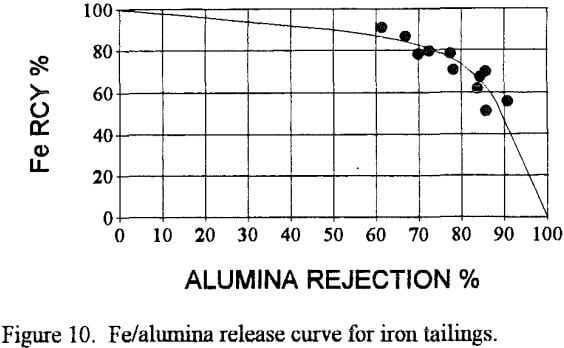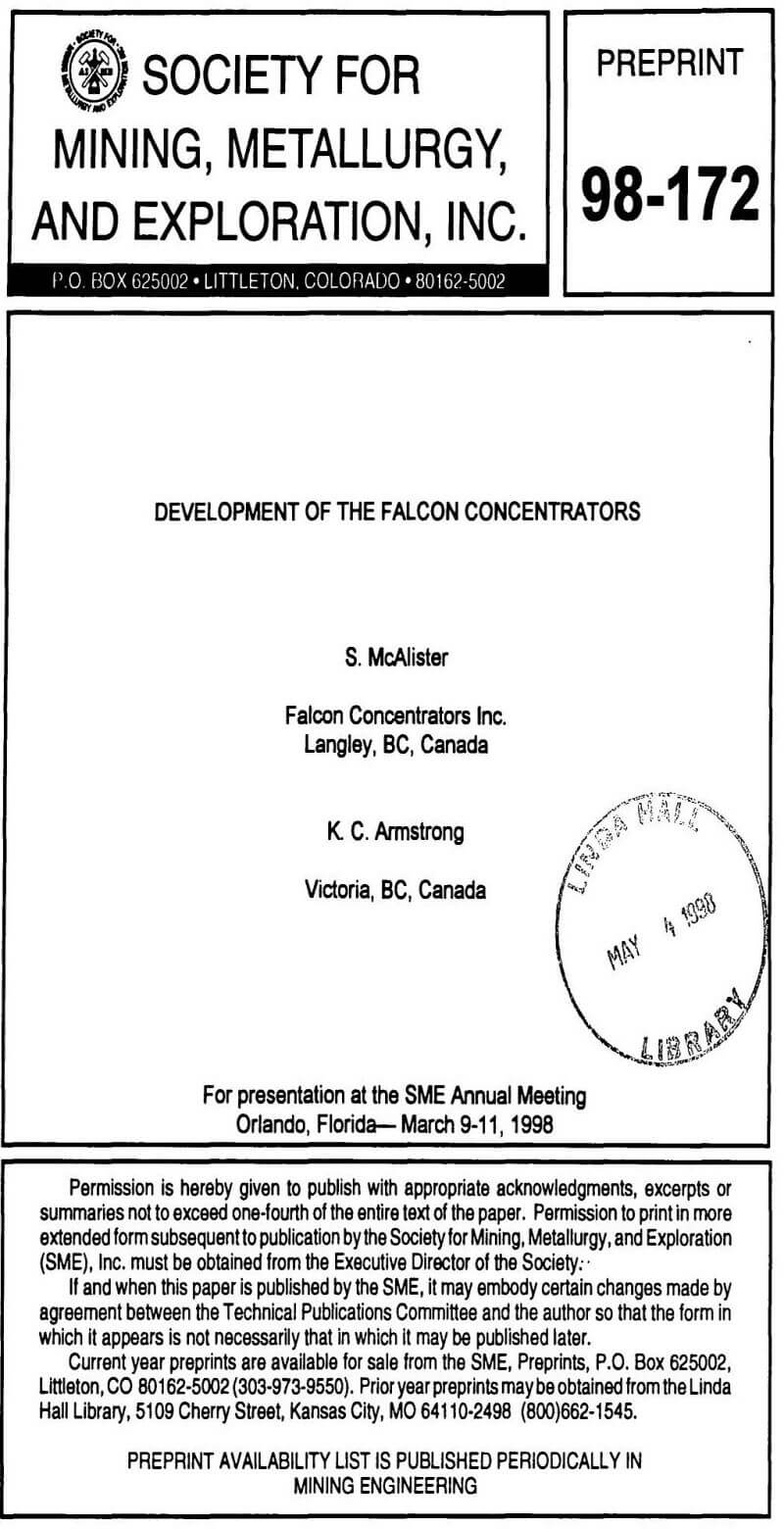Table of Contents
Elutriation
Another enhanced gravity device was patented in 1935 by A. N. MacNicol (Figure 4). It is also a truncated cone but ribs divide the length into a series of slots. A water jacket and connecting holes are used to inject water and elutriate a bed of material in each. Some companies have produced this type of 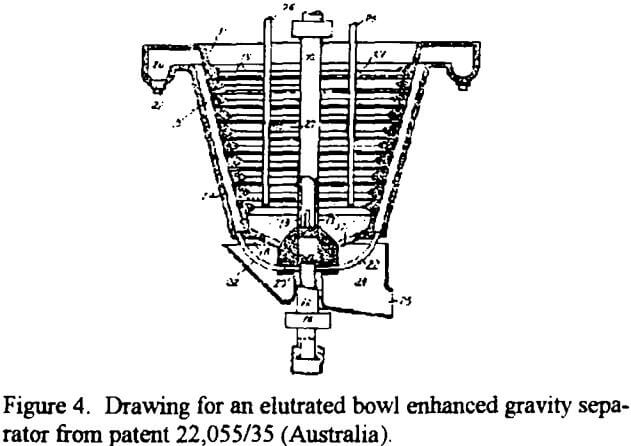 enhanced gravity separator, the Knelson being the best known. Concentration by a MacNicol is different because it uses a fluidized bed (eluition) into which heavier minerals sink. Coarse heavy minerals readily penetrate the bed and displace lighter ones. By adjusting the pressure the operator changes the flow to suit the conditions. With large size differences between the top size of gangue and the targeted mineral, the water flow can prevent fines entry. Parallel tests on the same material showed the Falcon B to be generally poorer on coarser feed and superior on finer feeds. At the same size of feed the Falcon showed better recovery of fine particles. Elutriated bowls could be used in grinding circuits but water consumption per tonne was high and only a portion of the ball mill discharge could be treated. In spite of this their superior recoveries over jigs and the inherently high recirculating load of gold particles due to selective recovery in the hydrocyclones resulted in their replacing jigs in grinding circuits. The Falcon’s non use of water made it practical for insertion in any circuit where water was critical.
enhanced gravity separator, the Knelson being the best known. Concentration by a MacNicol is different because it uses a fluidized bed (eluition) into which heavier minerals sink. Coarse heavy minerals readily penetrate the bed and displace lighter ones. By adjusting the pressure the operator changes the flow to suit the conditions. With large size differences between the top size of gangue and the targeted mineral, the water flow can prevent fines entry. Parallel tests on the same material showed the Falcon B to be generally poorer on coarser feed and superior on finer feeds. At the same size of feed the Falcon showed better recovery of fine particles. Elutriated bowls could be used in grinding circuits but water consumption per tonne was high and only a portion of the ball mill discharge could be treated. In spite of this their superior recoveries over jigs and the inherently high recirculating load of gold particles due to selective recovery in the hydrocyclones resulted in their replacing jigs in grinding circuits. The Falcon’s non use of water made it practical for insertion in any circuit where water was critical.
Two Stage Concentration
The “Super B” enhanced gravity separator is the first significant improvement to the MacNicol design in 60 years. It was conceived in 1994 as the combination of the best of both technologies. The Falcon migration zone was kept but the retention zone was to be elutriated to see if it would improve coarser gold recovery and handle coarser feed. Two concentric cylinders with end caps formed a water jacket with short holes through the inner wall. The retention zone was subdivided into a few slots for several reasons. With only 1/3 of the length having water injection, the total water consumption was kept low. All holes were at the same radius, so distribution of bed water was guaranteed. (Fig. 5)
Installations
The first SB machine, an SB21, was field tested on an alluvial deposit in central British Columbia in 1995. It performed with excellent recovery and without mechanical incidents or plugged holes. The same unit was then used at the QR mine without modification. In the first 24 hours production was in the kilograms of metal range and 25-40% recoveries were achieved after that. A scaling problem with the water inlets was solved later through the use of chemical inhibitors. The Mazowe plant in Africa found that gravity recovery went from 57 to 77%, cyanidation capacity downstream was liberated, and overall recovery rose 4%. Savings in labour, power, and maintenance alone gave a two year payback. Installation of an enhanced gravity separator in a gold plant does not always increase recovery measurably but will usually reduce costs. If it is followed by a cyanidation circuit there are significant savings in reagents, and if followed by flotation the revenue in bullion form usually surpasses that from metal in a flotation contract. Although each plant is different and companies understandably cannot disclose detailed economics, Falcon believes that all downstream savings should be considered when evaluating a purchase.
Since then SB machines have been replacing other devices around the world. Production units are made in 305, 530, and 965 mm (12, 21, and 38”) diameters. Wear parts costs are typically less than $US 0.01/MT with a maximum $0.03/MT in a severe application. Rated at 60 t/h, the workhorse SB38’s have a power consumption of 0.5 KWH/MT. Throughput at some plants has exceeded 90 t/h of -6mm material. FOB Langley, BC costs with the AutoPAC are under $US 100,000. A 1.47M SB58 version rated to 200 t/h has been designed.
Laboratory Work
A 100 mm (4”) lab unit collects about 100 grams of concentrate, enough for screen and assay. The recommended 5 kg. batch of feed gives a 50:1 mass concentration, high enough to define gravity recoverable gold in low grade samples. This large original sample became a useful tool for geologic assessment and testwork. Tests at independent labs using the same feeds have shown the SB4 to recover more mineral at higher grade than in lab devices using the MacNicol design. A study was done by Ancia, et al. using synthetic quartz ores with ilmenite as a heavy mineral gangue and tungsten metal to imitate gold. All showed 90 to 100 percent recovery by the SB4 in this exceptional case (there were no middlings). Galena from quartz separations were also demonstrated.
Selectivity
Galena with a high SGU and a cubic form should be a serious interference to gold recovery. At the Lepanto gravity/CIP mill, however, an SB38 achieved 30-35% recovery when the previous enhanced gravity separator at lower G’s averaged 4.5%, both in the presence of galena.
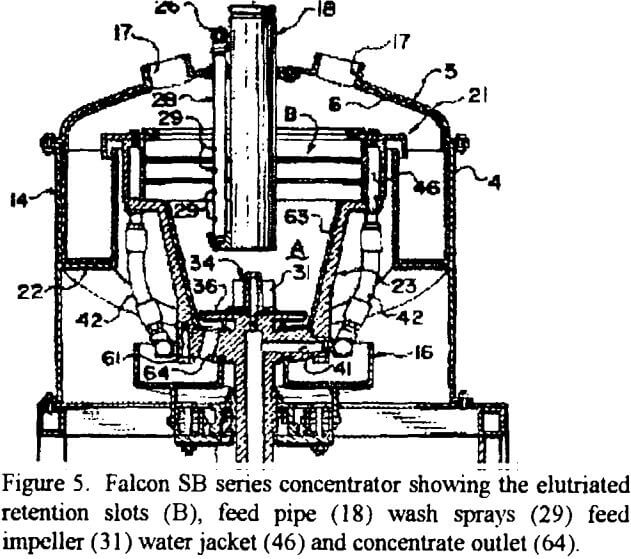
Continuous “C” Machines
Low SG Applications
In the coal industry the valuable material is typically SG 1.3-1.6 and rejection is desired for the ash at 2.6 SGU to raise the product value. Pyrite if present carries sulphur. SO2 is currently a penalty above 2.5 lb/MBTU in the US. Flotation of coal away from the gangue is the only technology to handle the fine material but in many mines the pyrite will float while in others the coal is oxidized and will not float. Flotation costs often exceed the value of the product but overall economics of cleaning coal are too complex to elaborate on here. A 10% coal middling particle will probably float but will have a density close to that of ash or pyrite and report as gangue when using gravity methods. One G devices have been used but with fines below 100 mesh (149µ) they were inefficient. Good ores are mined first and an increasing proportion of the remaining US coal reserves will produce fines. The potential for enhanced gravity to clean fine coal was seen by Dr. R. Honaker of Southern Illinois University in 1992. Tests with Illinois 5 coal using a B6 showed a release curve better than that for flotation for the same seam.
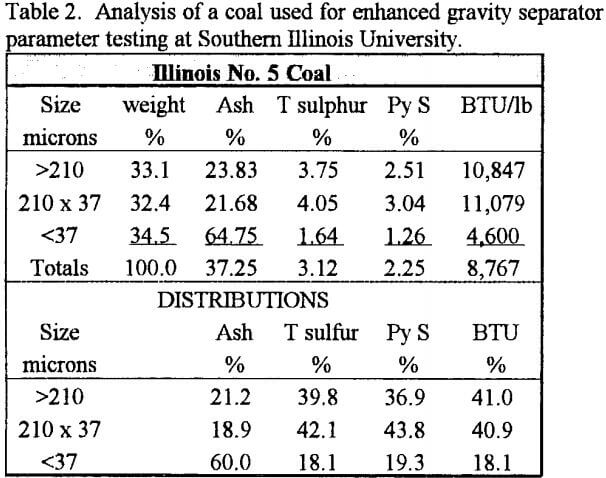
Mineral Sands
One world scale mineral sand deposit has not been developed because the contained titania mineral grains are predominantly 30-50µ making them difficult or impossible to recover economically with previous gravity’ technology. Recent testing with a C10 concentrator indicated that the heavy minerals can be economically concentrated. Of particular interest in this work was the fact that the ROM feed did not have to be deslimed. The concentrate was sufficiently dewatered to allow direct attrition scrubbing and it was deslimed, both steps were necessary for the intended following process.
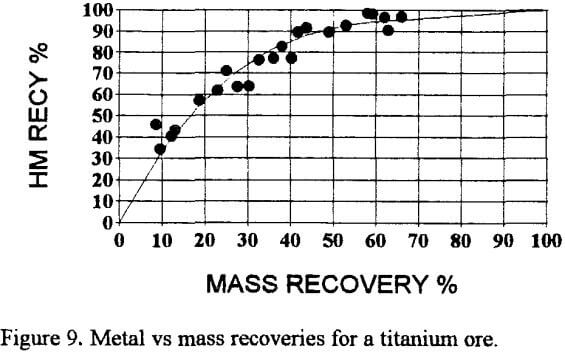
Ferrous metal
An iron mine using flotation to separate gangue evaluated enhanced gravity for the reject. The first 60% recovery carried little gangue. (Figure 10.) Recycle of Falcon concentrate to flotation feed, possibly after regrinding, is being investigated.
